To get you out walking
A review of 'Stroll: Psychogeographic Walking Tours of Toronto'

Stroll: Psychogeographic Walking Tours of Toronto
Stroll: Psychogeographic Walking Tours of Toronto
I have been going for walks since 1994 when I first moved to Montreal, long perambulatory explorations of back alleys, train yards, industrial wastelands and whatever neighborhood I found myself living in. So I was excited to hear of Stroll, as I’ve been interested in psychogeography for a number of years. I decided to take the book for a stroll …
I’m coming into Toronto from where I am spending the holidays with in-laws in Hamilton. The GO Train is the best way to arrive, the clicks and clacks of the rails warm and lulling as the train skirts along the lake past Exhibition and into the dark tunnels of Union Station. I’m leafing through the book, trying to decide which tour to take. I want to walk a route through areas I have never been, which would be most of Toronto. Plenty to choose from! But the season being dead of winter, I decide to go where it is most convenient. This is how I end up downtown.

Oh, glorious Toronto hot dog stands! Montreal has no street food to speak of. I watch the hot dog man score the hot dog to let out the juices, then grill it to barbequed perfection before dropping it neatly onto a fresh bun. To me, this is an essential part of Toronto.

As the man hands me my change, I drop most of it into his tip cup (thank you, he says, seeming surprised), and one quarter falls between my fingers, disappearing. I hope it didn’t fall into the pickles. I heap on the sauerkraut and the mustard, the things I like best on a hot dog, then wander off down Front Street, pausing to savor each hot, juicy bite. Hmmm.
Will I go down to the Harbourfront or over to Yonge Street? I look at the landscape to see how I feel. The Harbourfront would be to my right, where an underpass looks somewhat foreboding, not at all inviting. I decide to head over to Yonge.
Micallef starts his Yonge tour right at Lake Ontario, where he describes Captain John’s floating seafood restaurant. But how do I get to Yonge Street from Union? The lovely hand-drawn maps by Marlena Zuber help immensely, and there is a large, color foldout one at the back of the book.
One of psychogeography’s main methodologies, as described by Guy Debord and his Situationist cohort, is the dérive or the drift, and involves following one’s feelings (hence, “psycho-”) in response to the architecture and geography. A problem with taking a prescribed walking tour is the lack of spontaneity, for one is not able to “drift.” Of course, you could detour from the walk but then, do you try to get back to it or do you just wander? One could say that it matters not, for the book has already done its purpose, to get you out walking … (but then why read the book?)
Well, what I expect from a tour guide is knowledge of history and architecture. Micallef does a good job at including healthy doses of both on his tours, though I was always expecting more. Every time I saw something of interest, I wanted him to have also noted it, but of course, this doesn’t happen.
For example: As I reach Yonge Street, I am surprised to see the Hockey Hall of Fame there, as it wasn’t mentioned in the book. Instead, Micallef describes the Sony Center on the southeast corner as “a perfectly modern performance venue.” The Hockey Hall of Fame didn’t register in Micallef’s emotions? I’m not a hockey fan or a sports fan in general, but as with any icon of tourism, I have to stop and gawk. Like everyone else around me, I take a picture.

Turning the corner, I peer into the lobby where the entrance to the Hockey Museum is, and am surprised to see this space-age Christmas tree hanging over a fountain.

I’m compelled to enter and take more photos, alongside crowds of tourist families. The building is quite impressive, and there are these strange lights that look to me like floating Mickey Mouse heads.

Part of me protests, no, I’m a flâneuse (the feminine form of flâneur), not a tourist! But really, what is the difference? It’s only a slight readjustment of attitude! I have a camera, a guidebook, and I’m looking up at the buildings.
Micallef describes the area between Front and Richmond as “a concrete canyon,” with no particularly interesting pedestrian experiences to offer. The one building he notes is One King West, which is best seen from more of a distance, as its thin silhouette will attest. I crane my neck up to discover that I can barely see it.
But speaking of looking up at the buildings … I was astonished to find the unique juxtaposition of old and new architecture, everywhere I looked on Yonge Street! In fact, some of the old, stone buildings looked as though they had contracted some modernist virus that turned them into metal and glass.



I’d never before bothered to walk in the “touristy” areas of Toronto. I wander up Yonge with all the other families and couples through the capitalist display of wealth and glamour. The stores are mainly retail chains you can find anywhere, but it’s easy to just wander in a daze. Micallef has a good deal to say about the history of Yonge Street here: its big-city cliché moments, its glory years of tawdry spectacle, the early gay bars like the St. Charles Tavern and the Parkside Tavern that no longer stand, the Colonial Tavern where “jazz greats from Gillespie to Holiday to Brubeck played,” the grisly murder of a twelve-year-old shoeshine boy that prompted the cleanup of the street, and the eventual decline of Yonge. It’s a good read, though there’s nothing to look at in connection with it.
Micallef then takes us back to the present: “So where have you gone, Yonge Street? Walking along, it’s hard to find a drink in reasonable surroundings, and the good bands and DJs don’t play here anymore. The center of the strip now would appear to be Yonge-Dundas Square, probably the most controversial bit of real estate in the city … On humid nights, the air glows hundreds of meters into the sky around the square, as if filled with electrified neon” (22).
Arriving at Yonge-Dundas Square, I feel like I am in a smaller, less-crowded version of Times Square, obviously intentionally so. It also reminds me of Las Vegas, which looks almost run-down in the daytime, but is spectacular at night. I actually like the glitz, but in the light of day, the electric billboards aren’t as impressive against the grey, winter sky.

I note the diagonal crosswalks that I haven’t seen in any other Canadian city. How very megalopolis it is, like Tokyo, like London!

I drift around the Square for a while, looking at the holiday decorations and avoiding the young people giving away samples of synthetic cake. At this point I am beginning to get cold, so I decide to switch tours. Micallef follows Yonge Street all the way up into North York, past the 401 highway.
I consult the map and happily discover that Nathan Philip Square and the PATH System are only a few blocks away. The wind seems to blow colder and harder as I make my way from the crowds of Yonge Street to what I expect will be a fairly deserted City Hall. I arrive to the sounds to children screaming in delight. The ice rink is packed today.

I wander around the Square, checking out the space-age City Hall that I glimpsed once on an episode of Star Trek: The New Generation. It is surrounded by construction.

Micallef notes that there is a Henry Moore sculpture, which I find tucked away between scaffolds.
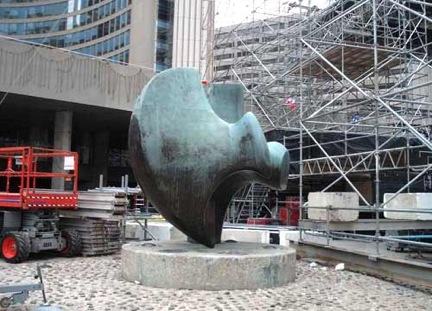
There are also portable washrooms behind the skating rink, strangely called “comfort stations.” This reminds me of “comfort women,” a euphemism for women forced into prostitution by the Japanese military during World War II. Of course I know this is unintended! But there you go, that’s what I thought of.
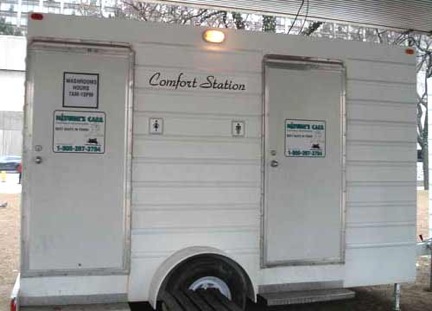
I’m really cold now, and the indoor PATH System sounds quite appealing. The PATH is a “twenty-seven-kilometer-long network of underground passages and tunnels that connects over fifty downtown buildings” (63). Micallef describes it as “Toronto’s version of Paris’s arcades, ‘a world in miniature’ where philosopher Walter Benjamin wandered in the 1920s when trying to understand that city. At first glance the PATH is a fairly generic shopping mall, but the impressive sum of its parts and the people who populate it make it remarkable. As you walk through it, the stores start to repeat like the background in a cartoon chase scene” (64).
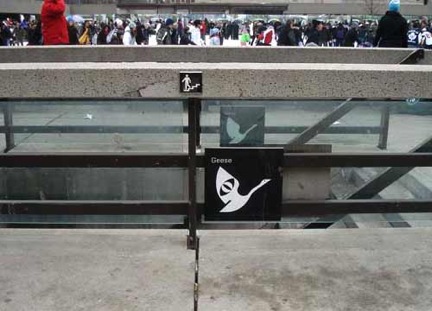
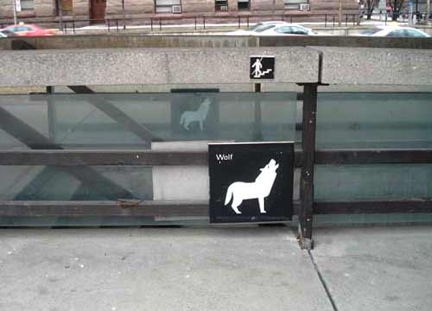
Now how do I get to the PATH? There are numerous stairways leading below, but it seems that these are leading to a parking lot (each whimsically labeled with Canadian fauna).
Micallef notes that City Hall is connected to the PATH, so I head in. Walking down the stairs to find the PATH, I find myself in what is considered its worst stretch, the very parking lot that I was trying to avoid. The supposedly car-free PATH goes through a parking lot? I’m a bit miffed that I wasn’t warned about this. As a flâneuse, I generally avoid dark-ish, underground parking lots as not the best place to be drifting around. However, the door locks behind me so that I can’t reenter City Hall, for some unknown reason (as I could easily get in above ground).
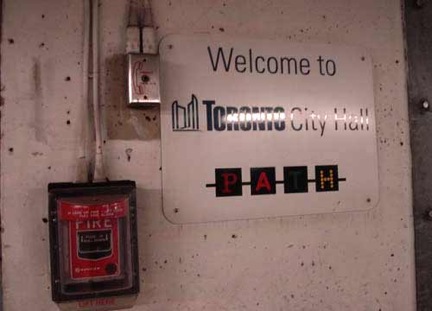
I see another woman wandering around, looking for the exit and talking on her cell at the same time. I spot a yellow striped road that should get me outta here, and I look for the woman but she’s gone in the opposite direction.
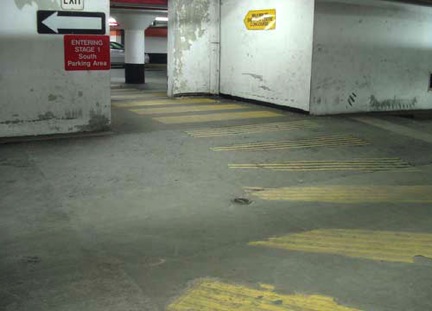
Cautiously, I follow the yellow striped road through the parking lot until I reach the basement of the Sheraton, which then quickly becomes mall-like, but the most deserted mall I have ever seen. Most of the stores are still closed for the holidays, and I spot only the occasional couple or family wandering through.
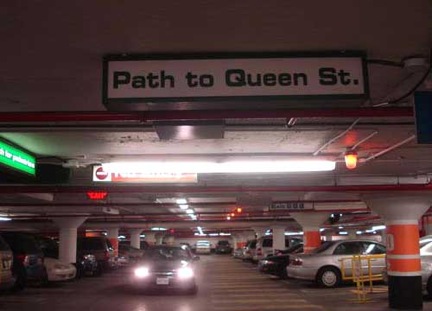
Without people to populate it, the PATH feels unremarkable, maybe even unsafe. I’m tired now, too, and I just want to get out. I exit the underground at the first opportunity and head back towards Union Station. My strolling here is done.
Now, I still live in Montreal, and have never lived in Toronto. My strategy in approaching Stroll is thus an outsider’s perspective. Walking in your own city, even if you go to places you have never been before, means walking with an accumulation of memories that make the city your own. It’s different when walking in a city that you don’t live in. I mention all this because Stroll is written for Torontonians; Micallef’s walking tours are based on his columns in the Toronto paper Eye Weekly. His narrative voice addresses the reader as “we” and assumes often that our points of reference are the same. For example, Micallef begins the walking tour “Spadina” like this:
Spadina is a strange word. Say it. Spa-die-nah. Now repeat it a few times. You’ll soon wonder how we use it in conversation without pausing in curiosity. Yet we say “Spadina” easily, and it means “Toronto” just as much as the Ojibway word it’s derived from, Ishapadenah (the word has various spellings), which means “hill” or “rise in the land.” To get a perfect view of the street, climb the Baldwin Steps at Davenport, stand next to Casa Loma and look south over Toronto and the southern, downhill length of Spadina … to its glittery, skyscaper end. It looks as if somebody cleared a wide swath of land through Toronto to make the street — the “spine of Toronto” as the late writer Matt Cohen called it — and, in a way, that’s true. (152)
Now, passages like this one make me want to go there and see it, regardless of whether I fit into his “we.” But one’s psychogeographic response to the city changes according to such identifiers as race, gender, height — all things that predict different emotional responses to, for example, a dark, underground parking lot. Micallef acknowledges this in his introduction, a “Flâneur Manifesto,” but I would have appreciated more awareness of it within the actual tours.
I was also disappointed to find that, while the Situationists — the originators of the term “psychogeography” — were “trying to strike a blow against capitalism and society” (as Micallef puts it in his Manifesto), Stroll takes a lighter view. But why divorce the historical context from the project? There’s a great opportunity here for political or social commentary, for an updated dérive that motivates involvement on a deeper level than “simply getting excited about a place.” A tourist observes, but a citizen engages and interacts.
Stroll’s tours are not really very psychogeographic then, if one is going to use that term. Although there are plenty of stories, histories, and interesting facts, I wanted more than a tour. I wanted more of Micallef’s own emotional mappings, more engagement. However, the writing does provide many interesting places to start, and getting to know your city might make you think about what it means to live in a city, and to be a citizen.
A series of reviews of walking projects
Edited byLouis Bury Corey Frost